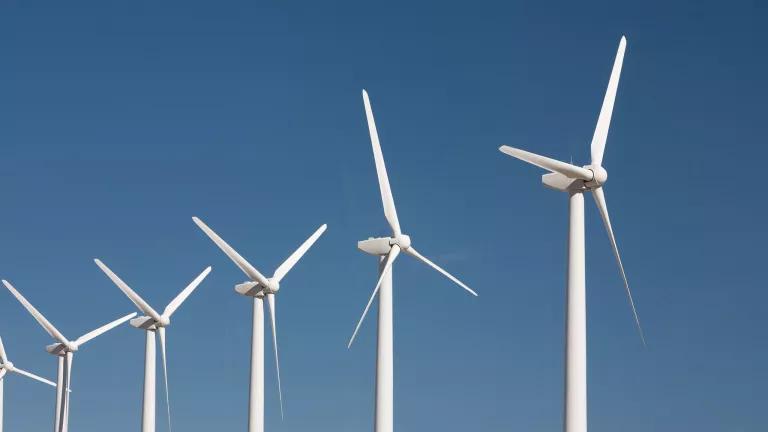Knocking the Wind Out of an Industry
By failing to renew the wind-production tax credit, Congress is killing fledgling wind farms.

On his travels in Africa, the fictional veterinarian Dr. Doolittle ran across a mythical antelope-like beast with a head on each end of its body. The “pushmi-pullyu” had difficulty moving because its heads pulled in opposite directions. I don’t think author Hugh Lofting had the U.S. government in mind when he dreamed up the creature, but his brainchild bears an uncanny resemblance to our national response to climate change. While the president is striking carbon-reduction agreements with world leaders, Congress is moving in the opposite direction. (I’ll let you decide which end of the animal is Congress.)
Case in point: the wind-production tax credit.
This credit, which gives 2.2 cents back to wind farms for each kilowatt-hour produced during their first 10 years of operation, is a benefit that has had a powerful influence on the industry. When President George H.W. Bush signed it into law in 1992, there were just 48 wind farms in the United States, with enough capacity to power 315,000 homes. Today there are more than 800 powering upwards of 15 million homes. And it’s exactly the sort of incentive the country needs if we are to cut CO2 emissions by more than a quarter in a decade, as President Obama has promised.
Congress, however, has other ideas (if that’s the right word): Over the past few years, it has repeatedly allowed the wind production tax credit to expire, only to reinstate it retroactively the following year. The credit last expired in late 2013, leading to yet another will-they-won’t-they farce that’s fit for a bad rom-com. So far, it’s unclear when federal legislators will reinstate the tax credit this year—or if they will at all—leaving wind developers twisting in the breeze.
Turbine farms in high-wind areas with good access to inexpensive transmission lines, such as the nation’s midsection, are profitable even without the tax credit, but the complex financing structure of wind farms make it crucial to many other projects trying to get off the ground.
A wind farm is a capital-intensive business. There is no fuel to buy, but the equipment costs big bucks—large facilities run more than $500 million upfront. The tax credit makes obtaining that much cash far easier. Developers sell the 10-year stream of income tax credits to banks, insurers, and other companies that have relatively predictable income levels. That contribution, together with some bank loans, can provide enough money to buy and install turbines.
Armed with that investment, the developer then finds buyers who wanted to lock in renewable-energy contracts, known as “power purchase agreements,” for several years into the future. The arrangement allows for all parties to enjoy a stable, reliable business relationship. Oh—and these agreements also help displace a bunch of coal- and gas-fired power plants that are destroying our planet.
The loss of the tax credit wouldn’t be fatal to developers who have already finalized power purchase agreements. They’re savvy enough to know the shenanigans of Congress, and the buyer and seller typically agree to a range of prices depending on whether the tax credit is renewed. Those already-in-progress projects are going to happen with or without the credit.
But that uncertainty is a much bigger problem for developers who are trying to put together new projects. When the price is uncertain, power buyers have no incentive to lock in a contract on a wind farm that may not come online for months or years. Instead, they simply wait for months to see whether Congress renews the credit, essentially putting the industry on hold.
“Everyone is dragging their feet in new deals right now,” says Nathaneal Greene, director of renewable energy policy at NRDC (which publishes Earthwire). “They don’t want to put any skin into a deal until they get a better reading from Congress.”
This tax credit isn’t cheap. It costs the government around $1.5 billion per year, but the benefits go beyond a diverse renewable-energy supply. A large wind farm creates more than 1,000 direct jobs. Additionally, an April report from the National Renewable Energy Laboratory points out that 550 U.S. factories manufacture components for the wind industry, and 60 of those produce only wind turbine parts. Over the last decade, the proportion of imported components has fallen steadily: It’s now just 30 percent. Wind energy is made in America.
If Congress doesn’t renew the tax credit, much of that business will be lost. The report estimates that without the benefit, we will only add around four gigawatts per year of wind power capacity between now and 2020. If the credit is renewed, however, we will add around 10 gigawatts per year, and possibly as many as 15.
The country has had more than enough of the pushmi-pullyu act, Congress. Just go where the wind takes you.
This article was originally published on onEarth, which is no longer in publication. onEarth was founded in 1979 as the Amicus Journal, an independent magazine of thought and opinion on the environment. All opinions expressed are those of the authors and do not necessarily reflect the policies or positions of NRDC. This article is available for online republication by news media outlets or nonprofits under these conditions: The writer(s) must be credited with a byline; you must note prominently that the article was originally published by NRDC.org and link to the original; the article cannot be edited (beyond simple things such grammar); you can’t resell the article in any form or grant republishing rights to other outlets; you can’t republish our material wholesale or automatically—you need to select articles individually; you can’t republish the photos or graphics on our site without specific permission; you should drop us a note to let us know when you’ve used one of our articles.

What’s the Most Energy-Efficient Water Heater?
How to Ditch the Biggest Fossil Fuel Offenders in Your Life
How You Can Stop Global Warming